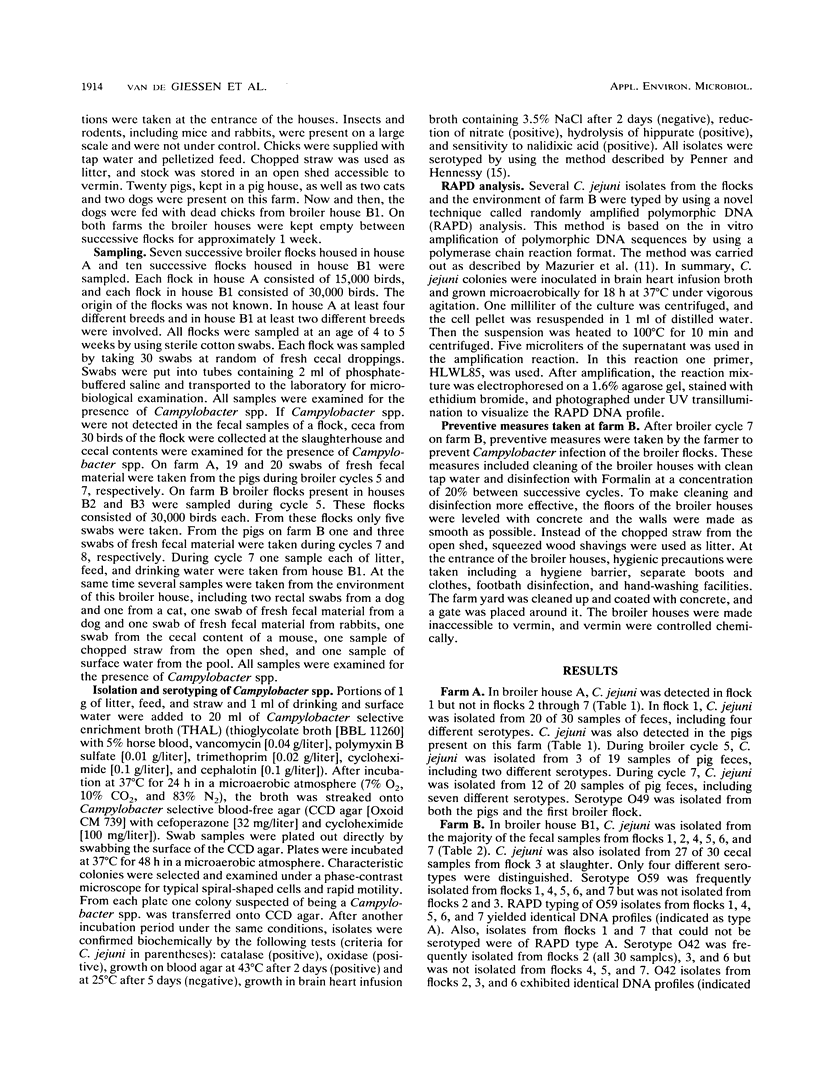Abstract
Broiler flocks are frequently infected with Campylobacter jejuni. The origin of the infection is still unclear. The question of whether colonization of flocks results from transmission of C. jejuni from breeder flocks to progeny (vertical transmission) or from environmental sources (horizontal transmission) remains to be answered. Therefore, in this study samples were taken from successive broiler flocks in two broiler houses (house A on farm A and house B1 on farm B) as well as from the environment of the houses. All C. jejuni isolates were typed by using the Penner serotyping system, and part of the isolates from farm B were typed by using a randomly amplified polymorphic DNA-typing system. In poultry house A, C. jejuni was isolated from the first flock but not from subsequent flocks. In poultry house B1, C. jejuni strains of the same Penner serotypes and exhibiting identical DNA profiles were isolated from successive flocks. Infection of the flocks from a common source via horizontal pathways is suspected, while a vertical route of infection is not likely to exist. Application of measures to control horizontal transmission of C. jejuni on farm B was successful.
Full text
PDF




Selected References
These references are in PubMed. This may not be the complete list of references from this article.
- Aho M., Hirn J. Prevalence of campylobacteria in the Finnish broiler chicken chain from the producer to the consumer. Acta Vet Scand. 1988;29(3-4):451–462. doi: 10.1186/BF03548642. [DOI] [PMC free article] [PubMed] [Google Scholar]
- Annan-Prah A., Janc M. The mode of spread of Campylobacter jejuni/coli to broiler flocks. Zentralbl Veterinarmed B. 1988 Jan;35(1):11–18. doi: 10.1111/j.1439-0450.1988.tb00461.x. [DOI] [PubMed] [Google Scholar]
- Blaser M. J., Taylor D. N., Feldman R. A. Epidemiology of Campylobacter jejuni infections. Epidemiol Rev. 1983;5:157–176. doi: 10.1093/oxfordjournals.epirev.a036256. [DOI] [PubMed] [Google Scholar]
- Doyle M. P. Association of Campylobacter jejuni with laying hens and eggs. Appl Environ Microbiol. 1984 Mar;47(3):533–536. doi: 10.1128/aem.47.3.533-536.1984. [DOI] [PMC free article] [PubMed] [Google Scholar]
- Kazwala R. R., Collins J. D., Hannan J., Crinion R. A., O'Mahony H. Factors responsible for the introduction and spread of Campylobacter jejuni infection in commercial poultry production. Vet Rec. 1990 Mar 31;126(13):305–306. [PubMed] [Google Scholar]
- Lindblom G. B., Sjörgren E., Kaijser B. Natural campylobacter colonization in chickens raised under different environmental conditions. J Hyg (Lond) 1986 Jun;96(3):385–391. doi: 10.1017/s0022172400066146. [DOI] [PMC free article] [PubMed] [Google Scholar]
- Oosterom J., den Uyl C. H., Bänffer J. R., Huisman J. Epidemiological investigations on Campylobacter jejuni in households with a primary infection. J Hyg (Lond) 1984 Oct;93(2):325–332. doi: 10.1017/s002217240006486x. [DOI] [PMC free article] [PubMed] [Google Scholar]
- Penner J. L., Hennessy J. N. Passive hemagglutination technique for serotyping Campylobacter fetus subsp. jejuni on the basis of soluble heat-stable antigens. J Clin Microbiol. 1980 Dec;12(6):732–737. doi: 10.1128/jcm.12.6.732-737.1980. [DOI] [PMC free article] [PubMed] [Google Scholar]
- Skirrow M. B. Campylobacter. Lancet. 1990 Oct 13;336(8720):921–923. doi: 10.1016/0140-6736(90)92282-m. [DOI] [PubMed] [Google Scholar]


